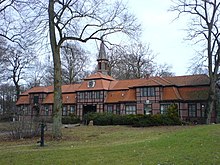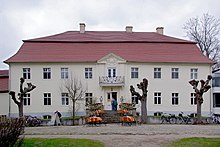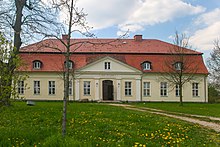Mansion (building)
A manor house or manor house is a building with an estate that is inhabited by the landlord . Depending on the region or size, it is often referred to as a castle . There are also other, regionally typical names.

General
Historically, the mansion and the castle differ less in their occupants than in their function. The terms castle and palace are etymologically rooted in defense; in the case of the castle, the term took on an expanded meaning since the Renaissance period . The manor house, on the other hand, is always the center of an estate, for example a manor or - in Schleswig-Holstein - noble estate (both are legal terms, because historically they presuppose a legal status, namely the membership of the estate owner in the locally organized knighthood represented in the state parliament) . In any case, a mansion was the center of an agricultural operation, a manor or at least an estate with arable farming or a winery , forest or pond.
The landlord - who could come from the nobility , but did not have to - was usually not only landowner and employer, but lord of a manor , i.e. he was responsible for the legal administration and allocation of land used for agriculture or forestry to the landholders (subjects) as well as the exercise of public law powers such as police force and jurisdiction . If a castle was only used for representative purposes (or, like a pleasure palace, for recreational purposes ) and if there was no farm business, it is not a mansion. If the manor house is particularly large or lavishly designed, it is usually referred to colloquially as a castle. In Schleswig-Holstein and Mecklenburg the designation "castle" was reserved for the houses of the sovereign , in Pomerania and Brandenburg it was originally also the houses of the people who sat in the castle (to whom the sovereign had given a special status).
The term “mansion” is used more in northern Germany. In the Middle Ages, castles were usually referred to as hûs ("house" in the sense of a permanent house - see Burg Niehuus ), which has remained in use to this day, especially in northern Germany, especially in the Rhineland , Westphalia and Lower Saxony , where castles, palaces or Manor houses of the lower nobility are usually referred to as House XY (e.g. House Lüttinghof ), similar to the English "XY House" ( e.g. Stowe House ). Further south, starting in Saxony and Saxony-Anhalt, in Bavaria, Baden-Württemberg or Austria, small mansions are also usually called "castle", "manor" or "courtyard". The former manor of the landlord in a Bavarian or Austrian Hofmark is called Hofmarkschloss in the Bavarian- speaking area . Other terms used locally are " Ansitz " (Tyrol) or " Campagne " (Bern).

The structural development of the mansions began with the emergence of agricultural goods (compare Meierhof ) around 1500. Originally it was a simple but massive apartment building that formed the center of the estate. In the documents of historical archive holdings, these houses are therefore often referred to as the permanent house . Often, however, they only had a field stone base and a half-timbered structure above it , as well as a vaulted cellar in some cases and a stair tower as an extension . In the first half of the 17th century, brick became popular for the outer walls. The manor house developed into a three-wing house that also visually dominated the surrounding landscape via two-wing systems. During the reconstruction after the Thirty Years' War, the manor house became the central building for larger courtyards. It was often preceded by a gatehouse that formed the entrance to the complex.
Mansions in Germany
Brandenburg

In Brandenburg , too, there is no clear demarcation between the castle and the manor house; such as at Blankensee Castle . Fontane already pointed out the contradiction in the use of the word “castle”, which has long been in use in Brandenburg, but is incorrect. Nevertheless, he speaks of the courage of the Brandenburgers to use a "compensatory higher titulature" and joins the traditional designation as "castles", especially with regard to representative manor houses.
In the scientific literature, at least for the former Prussian provinces, the following "initial definition" prevails: A mansion is the residence of a privileged aristocratic manor (manor), which is closely related to the exercise and exercise of their manorial rights and duties. These rights and obligations relate to land, body and judicial rule as well as church and school patronage in the area of the respective manor district. Also closely related to these privileges was the so-called “land” or “district council” of the manor. Viewed overall, however, due to the complex socio-economic development of the groups of large landowners, which developed extremely heterogeneously, especially in the 19th century, the use of the word mansion must be weighed up on a case-by-case basis against the background of the respective epoch.
Mecklenburg-Western Pomerania
See: mansions in Mecklenburg-Western Pomerania
Similar to Schleswig-Holstein, the mansions in today's Mecklenburg-Western Pomerania could take on large proportions, but were never referred to as a castle unless they belonged to the sovereign. Noble families like the von Maltzahn owned a variety of estates in different regions of the country. In the 40-year existence of the GDR, the protection of manorial houses was not part of the program. The houses were rebuilt beyond recognition or used as a quarry and most of them were removed. In the meantime, however, people have become aware of the historical importance of the manor complex, so that many have been restored and given new uses.
North Rhine-Westphalia

In North Rhine-Westphalia , especially in the Münsterland , most of the mansions developed from formerly fortified castle and residential complexes. The simple designation as a house is much more common here than the term mansion ; but is used in a similarly flowing manner and the transitions from the house to the manor house to the castle are quite smooth and are used and interpreted differently. The name Hofeshaus is also used in the Wuppertal area .
The systems are very often found in connection with moats - which are called graves here - which underline the formerly defensive character of the house, e.g. B. in house stacks . In terms of art history, complexes from the Gothic to modern times can be found, many are also still inhabited and continue to be the focus of large estates. Other mansions are now used for cultural purposes and are also open to visitors. Well-known examples of Westphalian mansions are Haus Rüschhaus , Haus Bodelschwingh or Haus Kemnade .
Schleswig-Holstein


In Schleswig-Holstein the mansions are a defining part of the cultural landscape. They were the centers of the so-called noble estates , which were registered in the knighthood, but contrary to their name, at least in modern times, could also belong to commoners. Due to the fact that the Duchy of Holstein belonged to the German Empire (the Duchy of Schleswig remained a Danish fiefdom until 1864) and the centuries-long administration of both duchies by Denmark , an influential and wealthy landed gentry arose here, who often expand their estates to the size of a castle, for example in Borstel could.
In Schleswig-Holstein the mansions emerged from large manors, as testified by the large farm buildings and gatehouses that are typical for Schleswig-Holstein facilities and that often exceed the actual manor house in their dimensions (e.g. in Hasselburg ). From the Middle Ages to the Renaissance , the so-called multiple house has proven itself for many mansions in Schleswig-Holstein , here several long houses with their own saddle roofs were built along each other and varied with towers, gables and bay windows . Typical plants of this time are for example Ahrensburg , Nütschau and Wahlstorf . Even the lucky castle is decorated in this form. In the baroque era , castle-like designs prevailed for mansions ; The mansions on Emkendorf , Pronstorf or on the Wotersen in Lauenburg are among the most famous facilities of this time . Many houses have now also been given park-like gardens, of which the Jersbeker Park - which only exists in rudiments - is even gaining national recognition. Analogous to the development in palace construction, the mansions were adapted to the new taste of the time or rebuilt from classicism to historicism , Gut Knoop is a well-known example of a classicist mansion in the country, Breitenburg for a neo-Gothic.
The history of the manor house in Schleswig-Holstein is not over yet, many facilities are still inhabited today and some have even been family-owned for centuries, they are the focus of rural goods and / or cultural meeting places, such as Salzau . At the same time, the historical facilities place great demands on the preservation of monuments and the financial possibilities of their owners.
Rest of Prussia
→ See: manor district
Non-German speaking areas

Western and Northern Europe
In England and Ireland as well as the southern states of the USA the terms manor , house or hall are common for a mostly noble estate. Famous mansions in the United Kingdom include Wilton House , Petworth House , Stourhead , Mount Edgcumbe House and Lancaster House . In Sweden, Norway and Denmark herrgård and herregård are used. In France , the term manoir is common. In the Dutch province of Groningen , the rural stone houses extended to mansions are called Borgen .
Eastern Europe
In earlier Eastern European countries, such as Poland-Lithuania or Hungary, where the nobility made up a relatively high proportion of the total population, mansions were often of very modest size and made of wood, but were nevertheless characterized by a special shape and designed with a park. This type of mansion is called dwór (“courtyard”) in Polish , in contrast to pałac (“castle”), which belonged to the nobility.
Crete
Manor houses also appear in other cultures and historical contexts; for example, in the Cretan-Minoan culture , a large, rich country villa is called a "mansion"; they were especially widespread in the Minoan culture (New Palace period, around 1700 to 1450 BC) on Crete .
Modern use
Since the historical function of the mansions as the center of a manor is no longer given, new concepts for use have become necessary, especially since the end of the land nobility in 1918 and again after 1945 (including land reforms ) and 1990. Today there are a wide variety of modern uses for historical mansions and manors. Examples are:
- Tourism concepts, such as hotel , guest house , hostel or hostel , apartments , restaurants - and café operation , horse riding , or spa and wellness equipment. Often different offers are made for tourist use, for private parties, weddings, tours, or there are rental options for bicycles and boats, or even sports facilities such as tennis and golf courses . Tourist concepts can be supplemented with medical offers, agricultural use, cultural events, museum concepts or other uses.
- Residential use, owner-occupied or rented apartments, old people's and nursing homes , assisted living , multi-generational homes , sometimes also as single-family homes (often in smaller buildings).
- Commercial use, as a representative company headquarters, congress and seminar location, training center, for individual offices, as a law firm , as a manufacture , as a shop or specialty store (e.g. antiques trade , building materials trade ), as a gallery or studio . Thanks to modern teleworking options and improved digital infrastructure, including in rural areas, more secluded mansions are increasingly being considered for employees and freelancers who mainly work via computer and telephone (see also: digital nomads ).
- Public use, as a museum, as a school, daycare center, as a municipal administration center, seat of a public institution, as a village and cultural center or community center , as an archive, clubhouse, or for public event rooms. Often, mansions owned by municipalities are used for several functions due to the large amount of space available. The concepts mentioned here can also be implemented by private operators, e.g. B. as a private school / boarding school or as a private museum.
- Medical, scientific or health use, as a spa facility , clinic , as a doctor's practice , regional medical center , as a research facility or as a university-affiliated institute.
- Agricultural concepts such as farms, ecological farms , distilleries , breweries , wineries , sometimes with farm shops .
- Other uses, such as intercultural or religious centers (e.g. Mitsuko Castle ), as a rental warehouse , or as a diplomatic-consular representation .
See also
literature
- Sabine Bock : manors and manors. Reflections on the historical cultural landscapes of Mecklenburg and Western Pomerania. Edited by the State Center for Political Education Mecklenburg-Western Pomerania. Thomas Helms Verlag Schwerin 1996, 2nd expanded and revised edition 2001, 3rd revised edition 2007.
- Renate de Veer: Stone memory. Manor complexes and manor houses in Mecklenburg-Western Pomerania. A manual. 4 volumes. Stock & Stein u. a., Schwerin u. a. 2005–2008, ISBN 978-3-89995-499-9 (Vol. 1–3), ISBN 978-3-939401-28-5 (Vol. 4), (also: Halle, Universität, Dissertation, 2005: Historische Memories are palimpsests. ).
- Nils Meyer: Empty spaces. Dealing with monuments as a process of creating meaning using the example of castles and mansions in Brandenburg (= urban development and preservation of monuments. Vol. 14). Jovis-Verlag, Berlin 2009, ISBN 978-3-86859-081-4 .
Web links
- Manor houses in Mecklenburg-Western Pomerania
- Manor houses in Saxony, Lausitz, Anhalt, Thuringia and Lower Saxony
- Castles and mansions in the Nuremberg countryside
- Information from VVV Groningen about the Borgen in the province of Groningen (de) ( page no longer available )
Individual evidence
- ↑ Alte Schlösser: Usage Concepts Asked , FAZ Online, December 16, 2008


